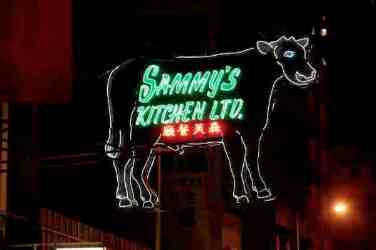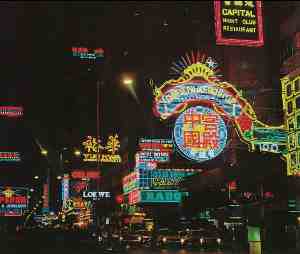ABOUT STOP PRESS
Stop Press is ISBN Magazine’s guide to happenings in Hong Kong. From art to auctions and from food to fashion, to entertainment, cinema, sport, wine and design, scroll through the best of the city's dynamic cultural offerings. And if your event merits mention in our little book of lifestyle chic, write to us at stoppress@isbn-magazine.com
Signs of the Times

The neonscape of three- and four-storey electronic signs has been a trademark of Hong Kong's street life - and its cinema - for decades, like a signature of approval. But while relentless property and retail development sweeps out characterful old for panglossian new, neon has become less luminous in the ever-changing palimpsest.
"Neon signs, which hold a prominent position in the visual culture of Hong Kong, are fast-disappearing from the city's urban landscape," says Dr Lars Nittve, Excecutive Director of M+, Hong Kong's future museum for visual culture in the West Kowloon Cultural District.
NEONSIGNS.HK, M+'s first online interactive exhibition, is a reaction to their demise. As well as celebrating this key feature of the city's urban landscape by researching, exploring and revealing stories behind individual neon signs - members of the public are invited to contribute to the museum's research by uploading images and stories of their favorite signs to an electronic "Neon Map", via Instagram, e-mail, and the Neonsigns.Hk website. These will be searchable by district and "featured" sections, and sharable through social media.

The site will be updated with new curatorial content - essays, slideshows, videos and timelines - to provide a richer view of Hong Kong's neon signs from the perspectives of craft and industry, design and typography, urbanism, cinema, visual art, literature and popular culture, within both local and global frameworks.
The exhibition is also a public call to action. "The intention is to elicit the public's help in documenting and researching the city's remaining neon signs--but also to further a discussion about the multiple readings offered by these once ubiquitous landmarks of Hong Kong's streetscapes,” say Nittve.
M+ recently bought two of the city's most recognizable neon signs: the neon cow that hung above Sammy's Kitchen steakhouse in Sai Ying Pun since 1977, and a Kai Kee Mahjong School rooster sign, dating from 1976, from the company's now-closed branch in Kwun Tong. At one time, Hong Kong had the world's biggest neon sign sponsored by Nanfang Pharmaceutical Factory's 999 brand of traditional Chinese medicines; it stood six stories tall, 111-metres wide, weighed 80 tons and beamed from the Shun Tak Centre in Central. The three figure '9's were made up of more than 13 kilometres of tubing; a neon-colonial sign of the times.
NEONSIGNS.HK - until June 30, 2014; Instagram: #HKNEON
Signs of the Times

The neonscape of three- and four-storey electronic signs has been a trademark of Hong Kong's street life - and its cinema - for decades, like a signature of approval. But while relentless property and retail development sweeps out characterful old for panglossian new, neon has become less luminous in the ever-changing palimpsest.
"Neon signs, which hold a prominent position in the visual culture of Hong Kong, are fast-disappearing from the city's urban landscape," says Dr Lars Nittve, Excecutive Director of M+, Hong Kong's future museum for visual culture in the West Kowloon Cultural District.
NEONSIGNS.HK, M+'s first online interactive exhibition, is a reaction to their demise. As well as celebrating this key feature of the city's urban landscape by researching, exploring and revealing stories behind individual neon signs - members of the public are invited to contribute to the museum's research by uploading images and stories of their favorite signs to an electronic "Neon Map", via Instagram, e-mail, and the Neonsigns.Hk website. These will be searchable by district and "featured" sections, and sharable through social media.

The site will be updated with new curatorial content - essays, slideshows, videos and timelines - to provide a richer view of Hong Kong's neon signs from the perspectives of craft and industry, design and typography, urbanism, cinema, visual art, literature and popular culture, within both local and global frameworks.
The exhibition is also a public call to action. "The intention is to elicit the public's help in documenting and researching the city's remaining neon signs--but also to further a discussion about the multiple readings offered by these once ubiquitous landmarks of Hong Kong's streetscapes,” say Nittve.
M+ recently bought two of the city's most recognizable neon signs: the neon cow that hung above Sammy's Kitchen steakhouse in Sai Ying Pun since 1977, and a Kai Kee Mahjong School rooster sign, dating from 1976, from the company's now-closed branch in Kwun Tong. At one time, Hong Kong had the world's biggest neon sign sponsored by Nanfang Pharmaceutical Factory's 999 brand of traditional Chinese medicines; it stood six stories tall, 111-metres wide, weighed 80 tons and beamed from the Shun Tak Centre in Central. The three figure '9's were made up of more than 13 kilometres of tubing; a neon-colonial sign of the times.
NEONSIGNS.HK - until June 30, 2014; Instagram: #HKNEON
